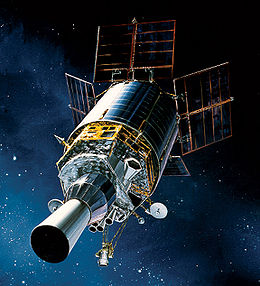Defense Support Program
During Desert Storm, for example, DSP was able to detect the launches of Iraqi Scud missiles and provide timely warnings to civilians and military forces in Israel and Saudi Arabia.
[1] The satellites are in geosynchronous orbits, and are equipped with infrared sensors operating through a wide-angle Schmidt camera.
The entire satellite spins so that the linear sensor array in the focal plane scans over the Earth six times every minute.
All 23 satellites were built by the prime contractor Northrop Grumman Aerospace Systems, formerly TRW, in Redondo Beach, California.
The original DSP satellite weighed 2,000 pounds (900 kg) and had 400 watts of power, 2000 detectors and a design life of 1.25 years.
The numerous improvement projects have enabled DSP to provide accurate, reliable data in the face of evolving missile threats.
[8] DSP-19 was a USAF Defense Support Program missile early warning satellite equipped with an infrared telescope to detect rocket launches.
There were five major improvement programs on the 23 satellites: More recently, there has been some effort put into using DSPs' infrared sensors as part of an early warning system for natural disasters like volcanic eruptions and forest fires.

